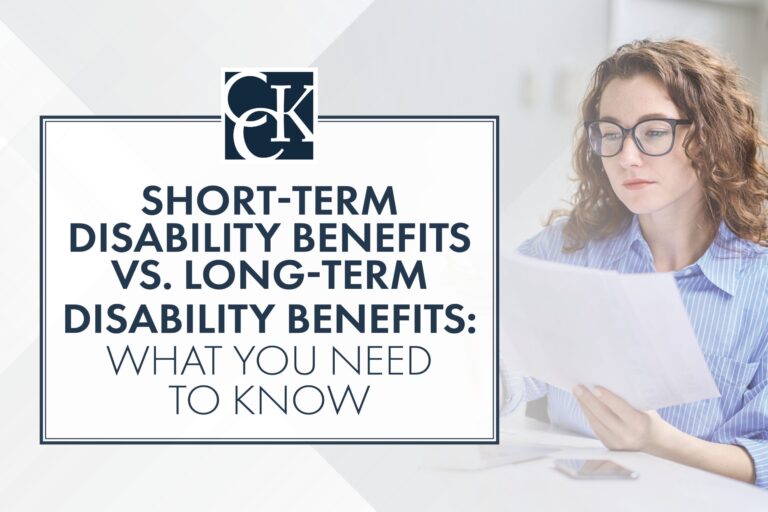Short-Term Disability Benefits vs. Long-Term Disability Benefits: What You Need to Know

There are commonly two types of disability insurance plans that you may have through your employer: short-term disability (STD) and long-term disability (LTD). While these two types of benefits are often similar, there are several key differences between them of which policyholders should be aware.
Understanding the differences between these two types of disability benefit plans can help you when you develop a debilitating medical condition that impacts your ability to work. Read on to learn the key differences between short-term disability and long-term disability benefits.
What Are Short-Term Disability Benefits?
Short-term disability benefits, as the name implies, are benefits intended for short-term use, typically covering a period of 6 months or less (although sometimes coverage can be longer).
For example, if you develop a medical condition that will only sideline you for a short while, typically 3 – 6 months, then STD benefits may be what you require. Policies, however, vary, so it is important to read yours to know what conditions may or may not qualify you for such benefits.
The elimination period for STD benefits, i.e., the waiting period before benefits begin in which you must meet the definition of disability, is typically only about 1 – 2 weeks long. Most STD plans will cover around 40 to 70 percent of a person’s income, although some STD plans cover more than that.
What Are Long-Term Disability Benefits?
Long-term disability benefits are meant to cover when a person cannot work for extended periods due to a debilitating medical condition or injury. Many conditions qualify for such benefits, though insurance companies still routinely deny such claims. Unlike STD benefits, LTD benefits can last much longer, sometimes until retirement age, as long as you continue to meet the terms of the policy. However, there can be certain policy provisions that limit the amount of benefits you can receive depending on the nature of your disability.

Moreover, the elimination period for LTD benefits is typically much longer than STD benefits. LTD benefits typically do not begin until 90 to 180 days after disability starts. This number, however, can fluctuate — it depends on the policy. The average amount for LTD benefits is usually around 60 to 80 percent of a person’s pre-disability wages.
Does ERISA Govern Short-Term and Long-Term Disability Benefits?
ERISA is a federal law that governs most employer-sponsored benefits, which includes both short- and long-term disability policies. However, not all STD plans are governed by ERISA. There is an exception to this rule called the “payroll practice exemption.”
The payroll practice exemption applies to short-term disability plans that meet the following criteria:
- The STD benefits must only cover current employees. If the benefits cover individuals who are no longer employed, then ERISA would govern the policy.
- Benefits must not exceed the employee’s normal compensation. To qualify as a “payroll practice,” the benefits that the policy provides cannot exceed the normal compensation of the individual; it must either be equal to or less than their normal compensation.
- The employer must fund STD benefits from its own assets: In other words, an employer cannot fund STD benefits from an insurer, from a trust, or from other third parties.
If a short-term disability policy does not adhere to the abovementioned criteria, then ERISA will likely still govern it. Of course, it is best practice to reference your plan documents and, if you have any questions, you can ask your employer directly.
Many employer-provided LTD plans are governed by ERISA. However, it is important to note that not all employer-provided LTD plans are ERISA-governed. For example, if you work for a church or a government entity then ERISA may not govern your claim.
How Do You Transition from Short-Term Disability to Long-Term Disability?
If you are disabled for a prolonged period and have both STD and LTD coverage, you may transition from short-term disability to long-term disability benefits. This process may be easier for claimants where both policies are provided by the same insurance company because the insurer will already have a lot of their information on file. In some instances, your insurer may initiate the process for LTD benefits before the elimination period ends to try and avoid a gap in benefits.

It is important to note, however, that if you were approved for STD benefits that does not guarantee an approval of LTD benefits, even if your STD and LTD coverage are both with the same insurance company.
The process of transitioning from STD benefits to long-term disability benefits may be more challenging if different insurance companies administer each policy. In such scenarios, you must initiate a new claim and ensure all your medical records and other evidence are submitted to the long-term disability insurance company.
Call Chisholm Chisholm & Kilpatrick Today
Regardless of whether you have a short-term or long-term disability policy, it is stressful when you need to file a claim. There is a myriad of paperwork and evidence you must gather and submit to your insurance company. Moreover, you must also manage your health. This can quickly become overwhelming. Luckily, this is not something you have to do alone.
A long-term disability lawyer from Chisholm Chisholm & Kilpatrick is prepared to help you with your claim. Our team has over three decades of collective experience dealing with LTD claims, and we know what insurance companies expect. We can help you navigate this process to help you obtain the benefits you need.
Call Chisholm Chisholm & Kilpatrick today at (800) 544-9144 for a free case evaluation. We will analyze your case and see if we can assist you.
About the Author
Share this Post
